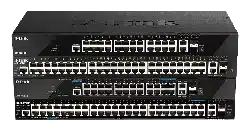Loading ...
Loading ...
Loading ...

DGS-1520 Series Gigabit Ethernet Smart Managed Switch Web UI Reference Guide
292
The Internet Assigned Numbers Authority (IANA) has reserved the address range from 232.0.0.0 to 232.255.255.255
for SSM applications and protocols. The Switch allows SSM configuration for an arbitrary subset of the IP multicast
address range from 224.0.0.0 to 239.255.255.255.
PIM-DM
The Protocol Independent Multicast - Dense Mode (PIM-DM) protocol should be used in networks with a low delay
(low latency) and high bandwidth, as PIM-DM is optimized to guarantee delivery of multicast packets and not to
reduce overhead.
The PIM-DM multicast routing protocol is assumes that all downstream routers want to receive multicast messages
and relies upon explicit prune messages from downstream routers to remove branches from the multicast delivery tree
that do not contain multicast group members.
PIM-DM has no explicit Join messages. It relies upon periodic flooding of multicast messages to all interfaces and
then either waiting for a timer to expire (the Join/Prune Interval), or for the downstream routers to transmit explicit
Prune messages indicating that there are no multicast members on their respective branches. PIM-DM then removes
these branches (Prunes them) from the multicast delivery tree.
As a member of a pruned branch of a multicast delivery tree may want to join a multicast delivery group (at some point
in the future), the protocol periodically removes the 'prune' information from its database and floods multicast
messages to all interfaces on that branch. The interval for removing 'prune' information is the Join/Prune Interval.
PIM-SM-DM
In the PIM-SM, RP is a key point for the first hop of the sender. If the first hop does not have RP information when the
sender sends information out, it will drop the packet and do nothing. Sparse-Dense mode will be useful in this
condition. In Sparse-Dense mode, the packets can be flooded to all the outgoing interfaces and pruning/joining
(Prune/Graft) can be used to control the outgoing interface list if RP is not found. In other words, the PIM Sparse-
Dense mode is treated in either the sparse mode or dense mode of the operation; it depends on which mode the
multicast group operates. When an interface receives multicast traffic, if there is a known RP for the group, then the
current operation mode on the interface is sparse mode, otherwise the current operation mode on the interface will be
dense mode.
Loading ...
Loading ...
Loading ...
